On November 17, I attended an event at the Walt Disney Family Museum called From Page to Screen: The Evolution of Snow White and the Seven Dwarfs. J.B. Kaufman was joined by Lella Smith, creative director of the Walt Disney Animation Research Library. J.B. (author, Disney historian, and brilliant public speaker) is considered by many to be one of the leading experts on Walt Disney’s version of Snow White. For this program, he didn’t disappoint.
Lella started the program off by telling us about the earliest versions of the classic fairy tale. Contrary to popular belief, the Grimm brothers (Jacob and Wilhelm) did not author the original story; rather they recorded several versions of it from all over Europe. In all of the versions there was a vain and evil Queen. In the Grimm version, the evil Queen was Snow White’s jealous mother who plotted to kill her young daughter at the age of seven.
Walt had a particular fondness for this tale, thanks to the memories of his grandmother reading it to him when he was very young. To improve the story, he made several changes. Originally, the prince never laid eyes upon Snow White until she was lying in the glass coffin. Walt knew the prince would have to be introduced much earlier in the story, which allowed for the creation of the magic wishing apple.
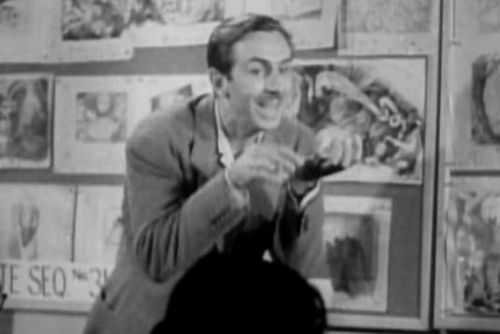 |
| "It's a magic, wishing apple" © Disney |
He also knew that Snow White wasn’t going to be seven years old. While never stating her actual age, Walt said that she should be old enough to be married.
Walt Disney was one of the greatest storytellers of all time. He had a brilliant knack for making changes or additions that considerably strengthened the story he was telling. One of the more powerful scenes in Disney’s Snow White was the Queen’s transformation, thanks to Walt’s idea to let the audience see her slowly change from a beautiful woman into a vile old hag. During the dark forest scene, Walt wanted the audience to feel the fear Snow White felt. Knowing how scary some of the scenes were, Walt didn’t want children under eight years old to view the film. Walt’s own daughter, Diane Disney-Miller, admitted she covered her eyes during several scenes when she first saw the movie.
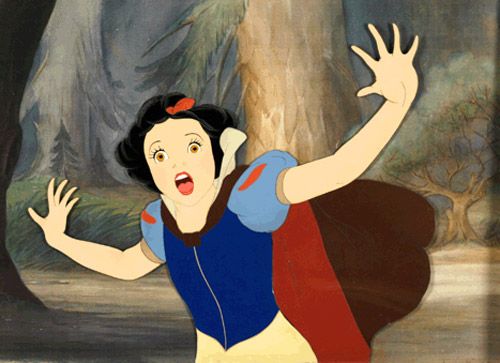 |
| Production cel of poor terrified Snow White © Disney |
Another cool detail Walt specified was to make sure the dwarfs' instruments appeared homemade. That’s why a flute looked more like a fish than it did a flute. The dwarfs lived in the middle of the forest, and didn’t have quick access to a local music store, after all! This exemplifies one of the many details that Walt and his animators took care to add, which put them head and shoulders above their competition (the small rips in the pool table during the Pleasure Island scene of Pinocchio is another wonderful example of this).
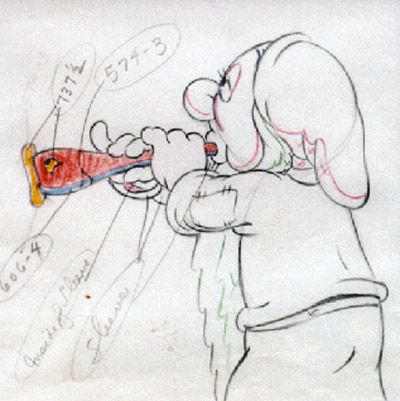 |
| Production sketch of Sleepy with his homemade flute © Disney |
Snow White’s heart wasn’t always the organ the Queen wanted the huntsman to retrieve. Body parts varied dramatically by version, one even pinpointing the young girl’s liver as evidence of her demise. Also, there were no forest animals prior to Disney’s version. But they were a brilliant addition, since they could communicate with Snow White, they were able to help the story along.
Lella wrapped up her segment of the program with this wonderful quote from the man himself: "It has always been my hope that our fairy-tale films will result in a desire of viewers to read again the fine, old original tales and enchanting myths on the home bookshelf or school library. Our motion picture productions are designed to augment them, not supplant them." ~ Walt Disney
J.B. Kaufman jumped right in with an astute observation of Snow White’s few detractors. “I think the people who made those criticisms don’t understand the art of making an animated film.” Some people felt that Walt strayed too far from the source material, while J.B. keenly disagreed. “Walt did come closer to the Grimms’ version than many of the versions before him,” he remarked. J.B. then proceeded to educate us about some of the aspects of those earlier versions.
Carl August Gorner did a stage version in 1856, and was the first to give the dwarfs names. They were: Blick, Pick, Knick, Strick, Rick, Dick, and Schick. The names were pretty much their only distinction from one another, with the lone exception of Blick being the “leader.”
The next adaptation came from Marguerite Merington in 1905 as a “Fairytale Play.” She actually adapted Gorner’s version instead of the Grimms’, and kept the dwarfs’ names. Blick was still the leader, but in her version, Schick stood out as sort of a goof. Winthrop Ames’ version came next in 1912, and he even hired Merington to help. Ames also made a few changes of his own. The names of the dwarfs became: Blick, Flick, Glick, Snick, Plick, Whick, and Quee. Quee was sort of the odd man out, and almost never spoke.
In case you were wondering about some of the early dwarf names Disney had in mind for its version, here’s a “short” list: Jumpy, Deafy, Dizzy, Awful, Wheezy, Baldy, Gabby, Nifty, Sniffy, Swifty, Lazy, Puffy, Stuffy, Tubby, Shorty, and Burpy!
Ames billed his production as the first play specifically for children. Because of that, the Queen and the old witch were written as two separate characters. While the Queen was still evil, the old witch was a somewhat comedic character who actually wanted Snow White’s heart for a hair-restoration concoction, as she was completely bald. Actress Marguerite Clark was 29 when she played Princess Snow White for Ames, and reprised the role in 1916 for a film version by Paramount.
Walt saw that film as a young boy in Kansas City. It had a big impact on him, and contributed to his decision to make Snow White and the Seven Dwarfs his first animated feature. J.B. screened clips of the 1916 film for us, and remarked how much different it was than the 1912 play. J.B. was also amazed at just how different it was from Walt’s version, since it had made such an impression on him. One of the funnier scenes we were shown entailed the dwarfs’ first encounter with Snow White, as she slept in their cottage. “What is it?” a title card read. “It’s a girl, I saw one before.”
With that, J.B. ended his portion of the program, and he and Lella held a brief Q&A with the audience. And yes, as usual, I bugged the presenters for a photo.
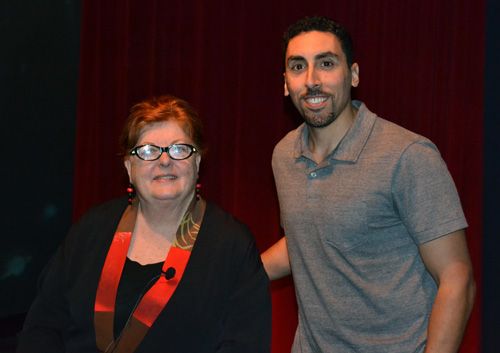 |
| Lella and me |
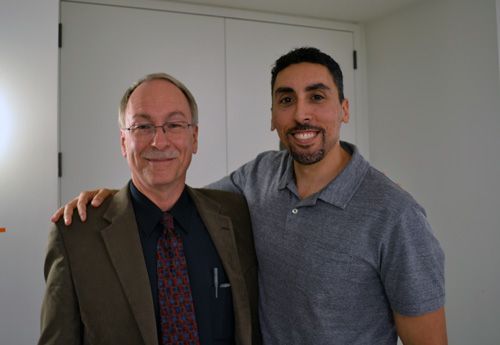 |
| Hangin' with J.B. |
After the program, J.B. stuck around to sign a couple of his latest books: Snow White and the Seven Dwarfs: The Art and Creation of Walt Disney’s Classic Animated Film, and The Fairest One of All: The Making of Walt Disney's Snow White and the Seven Dwarfs, the latter of which took J.B. about ten years to complete. To say the man did his research is an understatement.
Thank you Lella Smith and J.B. Kaufman for the great presentation. Lella did a great job, and J.B. was amazing, as usual.
Hi, im using the picture of sleepy for a school art project but i need more information on it, if you have it, can you tell me the artist, date, size and medium? Thanks so much, Kim
ReplyDeleteHi Kim. I don't have all that info I'm afraid, but let me look into it for you. Send me an email at: questions (at) thedisneyproject.com and I'll write back as soon as I find out!
Delete-Keith